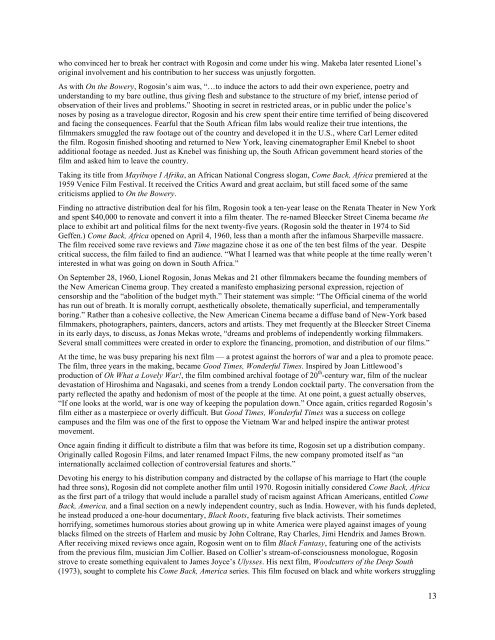Come Back Africa Press Kit - Get a Free Blog
Come Back Africa Press Kit - Get a Free Blog
Come Back Africa Press Kit - Get a Free Blog
You also want an ePaper? Increase the reach of your titles
YUMPU automatically turns print PDFs into web optimized ePapers that Google loves.
who convinced her to break her contract with Rogosin and come under his wing. Makeba later resented Lionel’s<br />
original involvement and his contribution to her success was unjustly forgotten.<br />
As with On the Bowery, Rogosin’s aim was, “…to induce the actors to add their own experience, poetry and<br />
understanding to my bare outline, thus giving flesh and substance to the structure of my brief, intense period of<br />
observation of their lives and problems.” Shooting in secret in restricted areas, or in public under the police’s<br />
noses by posing as a travelogue director, Rogosin and his crew spent their entire time terrified of being discovered<br />
and facing the consequences. Fearful that the South <strong>Africa</strong>n film labs would realize their true intentions, the<br />
filmmakers smuggled the raw footage out of the country and developed it in the U.S., where Carl Lerner edited<br />
the film. Rogosin finished shooting and returned to New York, leaving cinematographer Emil Knebel to shoot<br />
additional footage as needed. Just as Knebel was finishing up, the South <strong>Africa</strong>n government heard stories of the<br />
film and asked him to leave the country.<br />
Taking its title from Mayibuye I Afrika, an <strong>Africa</strong>n National Congress slogan, <strong>Come</strong> <strong>Back</strong>, <strong>Africa</strong> premiered at the<br />
1959 Venice Film Festival. It received the Critics Award and great acclaim, but still faced some of the same<br />
criticisms applied to On the Bowery.<br />
Finding no attractive distribution deal for his film, Rogosin took a ten-year lease on the Renata Theater in New York<br />
and spent $40,000 to renovate and convert it into a film theater. The re-named Bleecker Street Cinema became the<br />
place to exhibit art and political films for the next twenty-five years. (Rogosin sold the theater in 1974 to Sid<br />
Geffen.) <strong>Come</strong> <strong>Back</strong>, <strong>Africa</strong> opened on April 4, 1960, less than a month after the infamous Sharpeville massacre.<br />
The film received some rave reviews and Time magazine chose it as one of the ten best films of the year. Despite<br />
critical success, the film failed to find an audience. “What I learned was that white people at the time really weren’t<br />
interested in what was going on down in South <strong>Africa</strong>.”<br />
On September 28, 1960, Lionel Rogosin, Jonas Mekas and 21 other filmmakers became the founding members of<br />
the New American Cinema group. They created a manifesto emphasizing personal expression, rejection of<br />
censorship and the “abolition of the budget myth.” Their statement was simple: “The Official cinema of the world<br />
has run out of breath. It is morally corrupt, aesthetically obsolete, thematically superficial, and temperamentally<br />
boring.” Rather than a cohesive collective, the New American Cinema became a diffuse band of New-York based<br />
filmmakers, photographers, painters, dancers, actors and artists. They met frequently at the Bleecker Street Cinema<br />
in its early days, to discuss, as Jonas Mekas wrote, “dreams and problems of independently working filmmakers.<br />
Several small committees were created in order to explore the financing, promotion, and distribution of our films.”<br />
At the time, he was busy preparing his next film — a protest against the horrors of war and a plea to promote peace.<br />
The film, three years in the making, became Good Times, Wonderful Times. Inspired by Joan Littlewood’s<br />
production of Oh What a Lovely War!, the film combined archival footage of 20 th -century war, film of the nuclear<br />
devastation of Hiroshima and Nagasaki, and scenes from a trendy London cocktail party. The conversation from the<br />
party reflected the apathy and hedonism of most of the people at the time. At one point, a guest actually observes,<br />
“If one looks at the world, war is one way of keeping the population down.” Once again, critics regarded Rogosin’s<br />
film either as a masterpiece or overly difficult. But Good Times, Wonderful Times was a success on college<br />
campuses and the film was one of the first to oppose the Vietnam War and helped inspire the antiwar protest<br />
movement.<br />
Once again finding it difficult to distribute a film that was before its time, Rogosin set up a distribution company.<br />
Originally called Rogosin Films, and later renamed Impact Films, the new company promoted itself as “an<br />
internationally acclaimed collection of controversial features and shorts.”<br />
Devoting his energy to his distribution company and distracted by the collapse of his marriage to Hart (the couple<br />
had three sons), Rogosin did not complete another film until 1970. Rogosin initially considered <strong>Come</strong> <strong>Back</strong>, <strong>Africa</strong><br />
as the first part of a trilogy that would include a parallel study of racism against <strong>Africa</strong>n Americans, entitled <strong>Come</strong><br />
<strong>Back</strong>, America, and a final section on a newly independent country, such as India. However, with his funds depleted,<br />
he instead produced a one-hour documentary, Black Roots, featuring five black activists. Their sometimes<br />
horrifying, sometimes humorous stories about growing up in white America were played against images of young<br />
blacks filmed on the streets of Harlem and music by John Coltrane, Ray Charles, Jimi Hendrix and James Brown.<br />
After receiving mixed reviews once again, Rogosin went on to film Black Fantasy, featuring one of the activists<br />
from the previous film, musician Jim Collier. Based on Collier’s stream-of-consciousness monologue, Rogosin<br />
strove to create something equivalent to James Joyce’s Ulysses. His next film, Woodcutters of the Deep South<br />
(1973), sought to complete his <strong>Come</strong> <strong>Back</strong>, America series. This film focused on black and white workers struggling<br />
13


